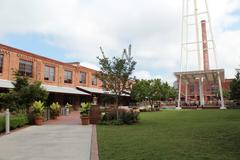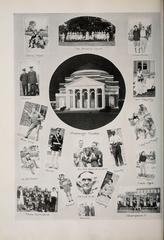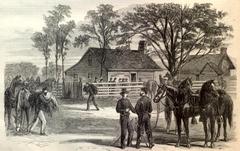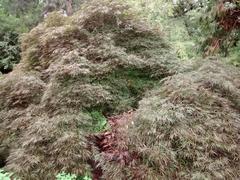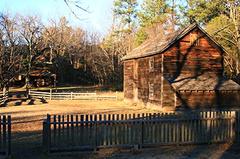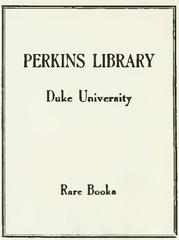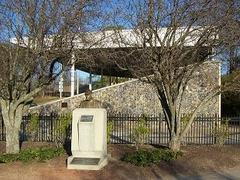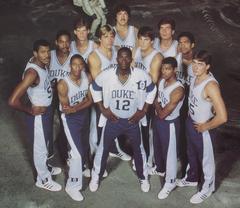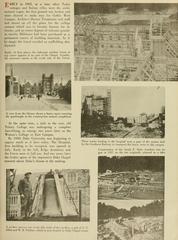
Duke University East Campus Visiting Hours, Tickets, and Durham Historical Sites Guide
Date: 04/07/2025
Introduction
Duke University East Campus in Durham, North Carolina, is a cornerstone of collegiate history, architectural distinction, and vibrant campus life. Established in 1838 as Brown’s Schoolhouse and later evolving into Trinity College, East Campus represents the transformative journey to what is now Duke University. Renowned for its striking Georgian architecture and deep-rooted traditions, the campus serves as both a historic site and the exclusive residential area for first-year undergraduates since 1997.
Open daily with free admission, East Campus seamlessly connects academic heritage with Durham’s cultural neighborhoods, such as Trinity Park and Ninth Street. Visitors can enjoy walking tours, student-led experiences, and access to nearby attractions like Sarah P. Duke Gardens and the American Tobacco Historic District. This comprehensive guide synthesizes key details on history, architecture, visiting hours, ticketing, accessibility, and practical travel tips—ensuring a rewarding and accessible visit for all. For further planning, utilize official resources such as the Duke Admissions Visit page, Duke interactive campus map, and Discover Durham.
Table of Contents
- Historical Overview
- Visiting Duke University East Campus
- Campus Life and Community
- Integration with Durham
- Preservation and Legacy
- Key Buildings and Attractions
- Nearby Durham Highlights
- Visitor Tips
- Frequently Asked Questions
- Resources
Historical Overview
Early History and Relocation
The foundation of Duke University East Campus dates to 1838 with Brown’s Schoolhouse in Trinity, North Carolina. Trinity College, shaped by Methodist and Quaker influences, moved to Durham in the 1890s after a pivotal donation from Washington Duke. This transition, under President John F. Crowell, set the stage for the university’s expansion in a thriving urban environment (Duke University Archives).
Architectural Highlights
East Campus is celebrated for its Georgian architectural style—defined by red brick facades, white trim, balanced proportions, and classical ornamentation. The design sharply contrasts with the neo-Gothic West Campus, reflecting late 19th and early 20th-century collegiate trends (Duke Facilities and Campus Architecture). The campus is bordered by historic neighborhoods, fostering strong ties with Durham’s urban landscape.
Key Transformations
- Washington Duke Building Fire (1911): The destruction of the original building prompted the construction of East Duke and West Duke buildings, which remain central to East Campus.
- Women’s College Era (1938–1972): East Campus housed the Undergraduate Women’s College, reflecting the era’s gender-segregated education.
- Coeducation and First-Year Experience: In 1972, coeducation began, and since 1997, all first-year undergraduates reside on East Campus, promoting community and transition into Duke life.
Visiting Duke University East Campus
Hours and Admission
- General Hours: Open daily from 8:00 AM to 8:00 PM (some sources note 7:00 AM–11:00 PM; check for seasonal or event-based changes).
- Admission: Free for all visitors; no tickets required for self-guided visits.
- Building Access: Event venues and academic buildings may have restricted hours; check schedules in advance.
Tours and Accessibility
- Guided Tours: Available Monday–Saturday via the Duke Admissions Visit page. Advance reservations are recommended, especially for student-led tours.
- Self-Guided Tours: Utilize the Duke interactive campus map or mobile apps for audio-narrated experiences.
- Accessibility: The campus is wheelchair-friendly, with ramps, elevators, and ADA-compliant pathways. Contact Access and Accommodation Services for specialized needs.
Travel Tips
- Parking: Limited on-site parking; use public transportation or garages nearby. Parking Visitor Info
- Public Transit: Durham’s bus system provides convenient access.
- Walking/Biking: The campus is pedestrian-friendly with ample bike racks.
Campus Life and Community
East Campus is the heart of first-year residential life at Duke. Renovated historic houses and modern residence halls support community-building, while facilities like Brodie Recreation Center, Lilly Library, and the Student Union offer academic, social, and recreational opportunities. The campus loop is a favorite for walks, runs, and student events (Duke Chronicle).
Integration with Durham
East Campus’s proximity to Trinity Park, Broad Street, and Ninth Street connects visitors to Durham’s vibrant culture, independent shops, cafes, and restaurants. The campus’s open layout encourages exploration and interaction between university and city life (Discover Durham).
Preservation and Legacy
Preservation efforts maintain East Campus’s historical character and landscape, honoring its Georgian roots while accommodating modern needs. Initiatives include restoring Olmsted Brothers’ landscape vision and recognizing the contributions of architect Julian Abele (Duke Today on Landscape Restoration).
Key Buildings and Attractions
- Baldwin Auditorium: An iconic concert hall designed by Julian Abele, hosting musical performances and cultural events (Duke Admissions).
- Mary Duke Biddle Music Building: Central to music education, adjacent to Baldwin Auditorium (Duke Chronicle).
- Duke Coffeehouse: Student-run music and arts venue in the Crowell Building.
- Crowell Building: Multipurpose hub for student organizations and events.
- Residence Halls: Including Alspaugh, Bassett, Blackwell, Brown, East, Epworth, Giles, Gilbert-Addoms, Pegram, Randolph, Southgate, and Wilson (Duke Admissions).
- East Campus Quad: Expansive green at the heart of campus life.
- Duke Arts Annex: Creative hub for visual and performing arts, just off campus (Discover Durham).
- Trinity College Site: Original site of Trinity College, with historical plaques and guided tours available (Duke Libraries Exhibit).
Nearby Durham Highlights
- Sarah P. Duke Gardens: 55-acre botanical garden between East and West Campus.
- Nasher Museum of Art: Premier art museum with rotating exhibits (Duke Admissions).
- American Tobacco Historic District: Dining, events, and entertainment.
- Ninth Street District: Lively area for shopping and dining.
Visitor Tips
- Best Times to Visit: Spring and fall for scenic beauty and comfortable weather.
- Essentials: Comfortable shoes, water, and sun protection.
- Photography: Allowed outdoors; check policies for indoor spaces.
- Events: Check the Duke Arts calendar and university events page.
- Self-Guided Tools: Use the Duke Admissions Tour app.
- Parking: Visitor parking details.
Frequently Asked Questions (FAQ)
Q: What are the visiting hours for East Campus?
A: Generally open from 8:00 AM to 8:00 PM (some sources indicate 7:00 AM–11:00 PM; confirm prior to visit).
Q: Is there an admission fee?
A: No, campus grounds are free to the public.
Q: Are guided tours available?
A: Yes, register in advance via the Duke Admissions Visit page.
Q: Is the campus accessible for individuals with disabilities?
A: Yes, with ADA-compliant entrances, parking, and paratransit services.
Q: How do I get tickets for performances?
A: Event tickets are available via the Duke Arts website or at box offices.
Q: What are top nearby attractions?
A: Sarah P. Duke Gardens, Nasher Museum of Art, Ninth Street, and American Tobacco Historic District.
Resources and Further Reading
- Duke University Archives
- Duke Facilities and Campus Architecture
- Duke Today on Landscape Restoration
- Duke Libraries Exhibit on Trinity College Origins
- Duke Admissions Visit page
- Duke interactive campus map
- Discover Durham
- Duke Arts website
- Duke Events Calendar
- Parking Visitor Info
Conclusion
Duke University East Campus offers a captivating blend of historical significance, architectural elegance, and dynamic student life in the heart of Durham. With free public access, a variety of tours, accessible pathways, and nearby cultural attractions, East Campus is ideal for visitors seeking an immersive collegiate and historical experience. Plan your visit today with the help of official resources and the Audiala app for interactive maps and exclusive content.






























